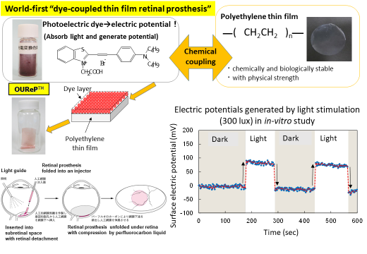Example
Photoelectric dye-coupled thin film as retinal prosthesis for the blind to gain the sight again
The Vision
Our eyes have photoreceptor cells which convert light energy to membrane potential to generate the vision. Patients who have lost photoreceptor cells in hereditary or acquired diseases have no treatment option at moment. Retinal prosthesis is a medical device to replace the function of dead photoreceptor cells and play a role at sending electric signals to the brain through the remaining neural cells in the retina which connect to the brain. We, as a team of multidisciplinary researchers together with small-sized companies at Okayama Prefecture, have used photoelectric dye molecules to stimulate the remaining retinal neurons to generate the vision.
Towards SDGs
We are planning to supply at a cheap price the photoelectric dye-coupled thin film retinal prosthesis to the blind people all over the world. No one left behind in the world is a basic concept in this project. Retinal prosthesis with multielectrode array system is now sold at an expensive price in US and Europe, and this cost is not affordable to most people in the world including Japan. Japan has maintained national health insurance system since 1961 to provide medical services at low cost to all people. Recently, however, expensive new drugs and medical devices which have been included in the health insurance system put a heavy burden on the finance of the system. A new device at low cost will be provided by industrial innovation, and thus, people’s good health and well-being will be maintained at equal opportunity all over the world, leading to reduced inequalities in the world. As partnerships for the goals, we are working as a multidisciplinary team which consists of experts in universities and companies.
Our way to come and go
We coupled stable photoelectric dye molecules on the polyethylene film surface to develop the dye-coupled thin film retinal prosthesis. We established a clean room facility at the Okayama University Incubator to manufacture the dye-coupled thin film retinal prosthesis in quality management system. The dye-coupled thin film had no toxicity in biological safety evaluation tests for medical devices. The dye-coupled thin films were proven to generate action potential spikes in degenerative retinal tissues of retinal dystrophic rd1 mice which lost photoreceptor cells. The dye-coupled thin films were implanted in monkey eyes with macular degeneration and were shown to restore amplitudes of visual evoked potential in the brain. We plan a first-in-human investigator-initiated clinical trial for the photoelectric dye-coupled thin film retinal prosthesis (OUReP) in patients with retinitis pigmentosa who have lost the vision.

Representative
